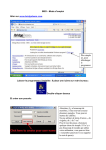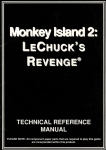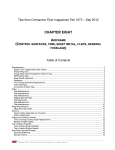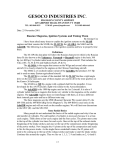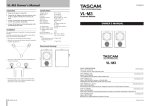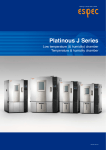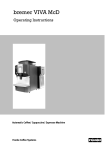Download Winter - QuietCornerBands.Org
Transcript
THE NOR’EASTER – Newsletter of the North East Tribe Winter 2010 MESSAGE FROM THE TRIBE CHIEF Welcome to 2010. I hope this will be an outstanding year for all of you, and that you have opportunity to give your Comanche plenty of exercise. To help you out with that, we’re planning a number of local fly-ins – and the next one is February 12 in Lancaster, PA (look for more information in a separate e-mail.) We’ll also let you know about upcoming events in near-by Tribe areas. Also, the International Convention is in San Diego this year – try it, you might like it. Keith Johnson, Tribe Chief This year, ICS established an Advisory Council of members to help out on various projects, add value to many of our activities, and learn the ropes of how the Society does business. Four of our members from the Northeast Tribe were selected: Robert Dagget, of PA; Scott Ducey, of NJ; Daniel Katz, of NY; and Pete Lautensack, of NY. Congratulations to these valiant volunteers. I expect we’ll all benefit from their service. On the technical side of things, the ICS board is working to develop a plan to ensure parts availability for our planes. We are aiming for a comprehensive solution, and considering several different approaches, some of which have been discussed on the ICS forum. It’s a big job, and we won’t have the answer this year, but we will be closer than we were before. If you have concerns or suggestions, please share them with any of your officers. All of us want to see the fleet keep flying, but we continue to lose Comanches in accidents; 11 singles and 8 twins in 2009 according to the NTSB database. It seems to be for the same old reasons: pilot judgment (fuel management and weather), flying skills (takeoffs and landings), and maintenance (gear collapse). There is no excuse for running out of fuel – regulation and common sense require that you know how much you need, know how much you have, and always land with a suitable margin. Weather can be trickier, but use all the resources available and always have options, always have an out, when you are facing serious weather. Remember how much practice it took to develop the amazing stick and rudder skills you had when you got your license – well, it takes almost that much practice to keep them sharp. I spent some time with my friendly local instructor this month, and I was surprised to see how much I was lacking on some basic maneuvers. Practice the basics every once in a while to make sure you really are as sharp as you think. You can also make the effort to take the Comanche Pilot Proficiency Program this year. We’ll be working to bring a program to our area, hopefully at least once each year. All retractable gear aircraft have special maintenance issues, and the Comanche is no different. Take care of your gear, and try to take care of problems at the first indication rather than when you can’t wait any longer. Not all of us can do our own maintenance, and in that case, the best thing you can do is find an A&P you trust and stay on his good side. Maintenance is very much a “pay me now or pay me later,” situation. And that usually means the “later” bill will be bigger than the “now” bill. Stay safe, and keep ‘em flying! 2009 – 2010 ICS – North East Tribe Officer Contact Information Tribe Chief: Keith Johnson [email protected] Asst. Tribe Chief: Pete Morse [email protected] Treasurer: Neal Pease [email protected] Scribe / Secretary: Scott Ducey [email protected] 302-242-8201 860-928-3323 802-238-0006 908-256-3158 DECEMBER GEORGETOWN DE (GED) FLY IN REPORT Saturday, December 12, was cold, but a bright and shining winter morning. CAVU weather, and the chance that this was the last good weekend of the year (and it was – the “snow of the century” started seven days later) resulted in a great turnout. We gathered in the bar area of the newly opened Lighthouse Landing restaurant, as Comanche fliers straggled in. Talk ranged from maintenance and availability of parts, to operational considerations and future fly-ins. We had 13 planes and about 20 people show up to enjoy the day. Parking was tight on the ramp, because the Delaware State University aviation department was having a student outreach event the same day, but we got there earlier and got most of the best parking. Our next event is planned to be another luncheon fly-in at Lancaster PA (LNS). This has always been a popular location, and I hope we see you there. Proposed NE Tribe Fly-Ins 2009 – 2010 December 12 Luncheon Sussex Co – Georgetown, DE (KGED) February 13 Luncheon Lancaster, PA (KLNS) April 18 Luncheon Williamsburg – Jamestown, VA (KJGG) May ?? Safety Expo / Lunch Daniel Webster College, Nashua, NH (KASH) June 11 – 13 2 – 3 Day Event Nantucket, MA (KACK) July 10 Luncheon Parlin Field – Newport, NH (2B3) August 14 Luncheon Tangier Island, VA (KTGI) September 18 Luncheon October 9 Luncheon Eastern WV Reg – Martinsburg, WV (KMRB) All fly ins are on Saturday, with Sunday as a rain date. Email notices will be sent two weeks in advance. Watch your emails for any changes in scheduled dates or locations. HORN INSPECTION SEMINAR By Scott Ducey (NE Secretary / Scribe) While some bad weather made its way up the Eastern Seaboard in mid-November, I decided to hop on a commercial flight to sunny California. The occasion? To attend the Horn Inspection Seminar hosted by the Southwest Tribe in Rialto, CA. The SW Tribe were gracious hosts, and saw to it that we had beautiful weather. The seminar was well attended, and a number of Comanche guru’s were present, including Kristin Winter and Hans Neubert. Before moving on here, I think it is worthwhile to point out that it was great to see this type of support being provided by ICS. Here were great Comanche minds gathered together to share important information concerning the safe operations and maintenance of our airplanes. All provided at no cost. It underscored to me the great value of being a member of the International Comanche Society, and how much we rely on the continued efforts of our volunteers. For those of you unfamiliar with the torque tube / horn issue, there have been reports of stress cracks and corrosion found on some of the singles. The torque tube and horn are critical components of the Comanche tail. Hans Heubert has been a point person that has been working with the FAA on this issue. Based upon my conversation with Hans, it appears that an AD is in the offing. But thanks to Hans hard work, it is believed that the AD will be a less burdensome one. He recommended to the FAA that the torque tube and horn be inspected every 1,000 hours or 10-years, whichever comes first. However, the FAA will make the final determination. It is likely that the AD will have an initial and recurrent inspection component. Kristin thinks the FAA will likely require all Comanches to be inspected once, both for safety and data gathering. Any recurrent inspections may fall more heavily on the singles because they have a thinner-walled torque tube. Kristin is optimistic that Piper will produce new horns and torque tubes and that by incorporating the new parts, the interval of inspection will be reduced or eliminated all together. W e gathered at 8:30am in Rialto at Art Scholl Aviation’s maintenance hangar. Some of you may remember Art as a famed airshow and stunt pilot who died in a crash while working on the movie Top Gun. Art’s widow, Judy, has continued to run their FBO ever since and was a wonderful hostess. Two airplanes were used for the seminar – N3764X, owned by Frank Berardo, and N7180P, owned by Chuck Parker. Both have owned their Comanches for over 5-years. The work began the night before when the elevators were removed, which exposes the torque tube. You will notice on the first picture below, there is some surface corrosion This was later taken off by sanding. In the picture immediately below, Kristin Winter pointed out that these two bolts SHOULD NOT be over-torqued as this could cause the horn and torque tube to be squeezed out of round, which is considered to be one of the reasons for the cracks. These should only be torqued to 65 in/lbs, plus the drag torque of the locking nut. Here is a good shot of the horn (center with the two bolts) and the torque tube horn: Here are a couple shots of a cracked horn. Die penetrant was used, and the red line is the stress crack. This horn was brought by Hans Neubert, and is not from one of the two airplanes used in the seminar. During the seminar, the SW Tribe had Dave Goodin take video footage of all the work being done. The plan is to put together a video to share with ALL of the ICS members through “Comanche Tube”. Since I am not a technical person, I will leave the more detailed description of the work for the video. Based upon what I saw and heard that weekend, this appears to be a significant issue that should not be over-looked. I was struck by how detailed and precise this work was. I was told that if not done properly, disassembly alone could cause damage to the horn / tube / balancing arm. It was clear to me that this work should be performed by an A&P mechanic that KNOWS Comanches. Even if you find someone that is well versed with the airplane, having your mechanic watch the video would be time well spent. Even though I am a Twin Comanche owner, and this problem has not been found with the PA-30, I still plan on having this inspection done on my airplane – for myself and my passengers safety, it is money well spent. Please note that a lot of information was shared at the seminar. What is presented here is only a small part of what was touched on. If you have questions, please post your questions on the ICS forum to those more familiar with this issue. Also note that there is a pdf file on the ICS web site that outlines the proper procedure for inspecting the horn. It is on the first page. A special thanks to Scott Meyers for coordinating this seminar, and to those that volunteered their personal time and expertise to helping all of us have a better understanding of this important issue. One final note, I took the picture immediately below on my way to the seminar. Only in California…. CHECKING YOUR GEAR RIGGING By Kristin Winter (SW Tribe Chief) One of the overlooked points on annual inspections is the rigging of the landing gear. Because the Comanche landing gear system does not have positive down latches, the system requires that transmission shut off at the correct instant. Too soon, and the gear may not be completely locked down. Too late and excessive stress will be placed on the transmission and other components. Mark Wilson of Aircraftsmen, who repairs the bellies of eight or so Comanches each year, estimates that more than half of the Comanches he sees in his shop were on the belly due to improper maintenance. Recently he had a very nice twin in for a new belly that suffered a gear collapse, even though the system had a recent 1000 hour check and was owned by a member who is meticulous. While it is difficult to be certain after the fact, it appears to have been a rigging issue. The transmission may have been shutting off before drag links had been pushed far enough over center to hold the gear down and locked. The service manual is a bit vague on how to adjust the microswitches to ensure that the gear motor shuts off at the right time. Each of the down limit switches should be adjusted to open at the point that the knee joint of the draglink just goes over center. The nose gear drag link, shown above, goes .187" over center. The down limit microswitch should be adjusted so that activates as the gear goes over center. If all three switches activates too soon, the motor will stop before the transmission has pushed the drag links completely to the stops and applied the necessary preload. The main gear drag link only goes .125" over center, but otherwise, the principle remains the same. The down limit microswitch must not activate until the drag link has gone over center. Problems with the landing gear are cumulative. Add a little wear to the bushings and bolts, a bit of mis-rigging, worn cables that have some give to them, tired gear motor, and you end up with an aircraft that will not reliably lock its landing gear down with enough force to ensure that it will not collapse on the next landing. There are a couple of checks that can and should be made. The service manual suggests having someone in the cockpit disconnect the transmission, set the extension bar, and pull up on the bar until the green down light goes out. Then the manual suggests having someone push on each of the gear legs to see if any of them will unlock and start to bring the landing gear up. One can use a rope or a small strap come-along to do this alone. This latter is probably a better technique as it allows the gear to be held in one position. That will give better results. With someone in the cockpit moving the lever, you can confirm that each down limit microswitch is activating at the proper time. This is a check that should be made at each annual inspection, but probably is not done by most IA’s. If you make this check on your own, make sure to cycle the gear a couple of times after reconnecting the transmission and checking that there is little to no movement when you push up on the over center point of the drag link, after the gear is down and locked. While cycling the landing gear, make sure that the transmission is not putting excessive force on the bulkhead to which it is mounted. I have seen a down limit switch adjusted so late, that the transmission was flexing that bulkhead which will at least lead to fatigue cracks if it doesn’t damage the fasteners outright. Remember, the landing gear only shuts off after the last down limit switch activates. Fly Safely! OCTOBER MARTINSBURG (KMRB) FLY IN REPORT By Keith Johnson, NE Tribe Chief Dismal weather held down the attendance at our October fly-in to Martinsburg WV (MRB.) Once again, member Jeff Grove hosted us at his hanger on taxiway B. Only about four planes made the trip to West Virginia, but it was good to see a few other Comanche flyers. There was talk about flying and maintenance at the hanger, and then the group moved up to the Runway Inn for lunch. After another great lunch and more sharing of knowledge, we all packed up and made our way home. Thanks, Jeff. COMANCHE SAFETY SPOTLIGHT: Heavy Iron Procedures for Light Aircraft From an article by Charles R. Morgenstein, “Aircraft Owner” magazine, July 2009, page 10 Pre-takeoff briefing: On most professional flights, the pilot flying will brief the crew on the procedures that will be used for departure. Even if you have to say it out loud to yourself, this is a great habit to get into. “We are cleared for takeoff on runway 31 with a 3-knot crosswind from the left. I will rotate at 65 knots and climb out at 110 knots. If 65 knots is not reached by mid-field I will abort on the runway. On engine failure below pattern altitude I will land straight ahead with only minimal turns. If pattern altitude has been reached, I will decide whether to attempt to return to the airport or seek an alternate landing site.” This forces the pilot to think about a rejected takeoff or an engine failure at low altitude. We probably all know someone who tried to turn back to the airport at too low an altitude following an engine failure, and didn’t make it. Saying what you intend to do before you take the active can help you avoid the compulsion to try it too. Pete Morse, Assistant Chief Sterile cockpit: Professional crews do not discuss any matters not concerned with the flight from engine start until 10,000 feet. Similarly, once the aircraft has been cleared to descend for approach to landing, until engine stop, professional crews discuss only issues related to the present and upcoming phases of flight. We who fly light aircraft can modify this rule so that, until established on initial cruise altitude and heading, no one says anything that the crew can hear unless it is directly related to the safety of the flight. Similarly, once cleared for descent for landing, the passengers and crew should confine themselves to safety-of-flight items only. Many of us know pilots who chatter from engine start to shut down. How many radio calls were missed? How many checklist items were never checked? Fly the airplane: Most of us learned this in primary flight training. It is vital, even is a small aircraft, to make sure that someone is always in command, and that someone is actually flying the aircraft. Use the system, but don’t depend on it: Whether flying IFR or VFR with advisories (Flight Following), use the system. Having people on the ground know who you are, where you are going, and what you are doing, is a good thing. But don’t become complacent. If you suddenly hear “Radar service terminated, resume own navigation, squawk VFR”, can you continue your flight without straying into restricted airspace? Double check the controllers: Unless given an “immediate” instruction, there is always time to make sure that the instruction makes sense. Controllers are human, and sometimes make mistakes. When cleared onto a runway, check to see if someone is on short final. Check down the runway to see if the last aircraft is clear and nobody is about to cross the active. In flight, if an instruction doesn’t make sense, ask the question. Don’t blindly follow when that voice in your head is telling you that something is not right. When cleared to land, check that the runway and all crossing taxiways really are clear. In an emergency, the insurance company owns the aircraft: If an airline crew is forced to land off airport, or on the airport with damage, they are not thinking about what will happen to the aircraft. They are thinking, “how can I save my life and the lives of my passengers and crew?” Light aircraft owners often think of their planes as a member of the family. We don’t want to see it hurt, and we try to save it. The moment the engine quits, a fire breaks out, or some other extreme event happens, think “The insurance company now owns the aircraft. I am going to sacrifice THEIR airplane as much as I need to in order to keep us alive.” By applying these “heavy iron” concepts to your normal, habitual procedures, there will be less risk of you being the one held responsible at trial, and your flying will be much safer. OBSERVATIONS ON A TWIN COMANCHE – THE FLIGHT INSTRUCTORS CORNER By Matt Minucci When I learned to fly a multiengine airplane a few years ago, the first impression I had about the landing phase was how much simpler it seemed compared to landing the single-engine Cessna 172s I had flown until that point. All that seemed was necessary for landing was to fly the plane relatively close to the runway and chop the power in anticipation of a consistent and predictable touchdown. The weight of an engine on each wing seemed to turn the aircraft into a lead brick when the engines were idle and powerless. I found that to be the case for a couple other twins I have had the opportunity to fly. Not so with the Twin Comanche! I had been duly warned about the low-slung main wing, merely inches from the ground, with the flaps fully-deployed, and about the quirky characteristics of its laminar-type airfoil. Admittedly, my first Twinkie landing wasn’t horrible; I had some time in singles with laminar-type wings, like the Cirrus SR22 and Mooneys. But in subsequent attempts, I quickly realized what all the hype was about landing this plane: consistency is certainly an issue and I was not immune. Another thing I noticed pretty quickly as I began to meet more Comanche flyers was how many modifications folks incorporate into their planes. Clearly there’s a lot to like about the plane! But there’s a few characteristics pilot-owners would rather, and do, change. And it seems often to be a modification to the wing in an attempt to better control stall characteristics throughout landing. I’m not a Comanche owner, but I do have the opportunity to fly one a few hours each year. If I can offer any—unbiased— suggestion about flying this airplane in the landing phase, it would be that it is imperative to constantly keep some basic aerodynamics lessons in the back of your mind. Then, get to know the Comanche you fly extremely well. Ground Effect. Recall how this makes a wing tough to stop flying. Flying the wing close to the ground, beginning about one wing span’s height above the ground, we see two main results. One, less total drag (over 40% less) and a more effective use of the total lift produced by the wing; that is, the lift being produced suddenly becomes more favorable to keeping the aircraft in flight. Lift Equation. The part to highlight here is the part about airspeed. As air travels over the wing faster, more lift results. In fact, it increases as the square of the airspeed. Experiment with this online airfoil simulator, and you’ll see the relationship: http://adamone.rchomepage.com/foil_sim.htm. More from the Lift Equation. The other part is the part about surface area, which is what happens when you deploy those huge Comanche flaps. More surface area yields more lift, all else being equal. Laminar Type Airfoil. The design intention of a laminar airfoil is to keep the lift-giving airflow hugging the surface of the wing as long as possible before it begins to break away into a turbulent wake. It is recognizable by the thickest part of the wing being placed around 40% of the wing chord rather than around 25%. This helps with other parts of your plane’s overall performance, like cruise, but it can contribute to the stall-stubborn Comanche wing during the landing phase. And when a laminar wing stalls, it tends to be suddenly. Of course, thinking in engineering terms is the last thing you want to do when you’re piloting your plane. Langewische showed us the value of pilots thinking in piloting terms and not engineering terms in “Stick and Rudder.” So what’s the takeaway here? Nail your approach speed! This is probably the most important aspect you can manage. Too much airspeed is going to bite you during the landing, and you’ll skip and float down the runway. Keep the nose of the plane in the same spot throughout the landing flare. In other words, keep the angle of attack increasing throughout the landing flare. As airspeed slows, there is a tendency for the nose to drop. Allowing this to happen might prematurely allow the gear—or worse, the nosewheel—to contact the runway, and may cause a skip or bounce. Any attempt to “plant” the plane on the ground by pushing on the yoke is going to simultaneously decrease angle of attack and keep the wing in flight. We need to bring the wing closer to stall, so use what elevator authority is still available to keep the angle of attack increasing. (Of course, be sure that your flight path continues to be earth-bound, not sky-bound, as airspeed decreases throughout the landing!) Raising the flaps at some point in the landing can also alter the shape for at least some of the wing, making the level flight stall speed higher. This will give the wing less reason to keep flying in the existing conditions. (You also need to consider whether the added workload of doing this during landing is a safe operation! If you decide to try this, do so with a competent pilot monitoring from the right seat until you feel comfortable.) Fly the plane into the landing and follow through with your attention until the airplane comes to taxi speed. A tailwheel lesson will reinforce the need for increased concentration as the landing progresses. We often do the opposite in tri-gear planes and tend to relax as soon as the wheels touch the runway. Remember Yogi Berra’s famous quip, “it ain’t over ‘til it’s over.” Maybe he knew something about Comanches. {Matt Minucci is a CFII Multi-Engine Flight Instructor based out of Certified Flyers in Morristown, New Jersey. He frequently flies a PA-30 with the ICS NE Scribe. He has been to Oshkosh, Sun N Fun, Key West in a 1969 Twin Comanche}. FERRYING A COMANCHE TO THE TWILIGHT ZONE By Scott Ducey (NE Secretary / Scribe) Submitted for your approval…I looked at a few Comanche's before buying my PA-30, and had an interesting experience that I thought I would share. The journey starts out with me ferrying a plane from several states away back to my home state of N.J. for a prebuy inspection. In short, I could not come to terms with the owner and the plane had to be returned. And this is where Rod Sterling would say, “we are about to enter the Twilight Zone.” I decided to hire an out of state ferry pilot. Why? Because it was inexpensive. Big Mistake!! On the day the plane was to be ferried back, I called the airport from work and asked if the plane had left - it had. I got back to my responsibilities, expecting all would go well. Later that evening I got a call from the owner asking where the plane was. I told him I didn't know what time it departed, but he should arrive shortly. I went to sleep early that evening, and the next day I noticed I had several calls from the stressed out owner on my cell THE PLANE NEVER SHOWED UP!! I panicked. Was there a crash? Was the airplane stolen? Later that day we found out the ferry pilot left the plane 20-miles away due to weather - strange, as the weather was supposed to be severe clear. A few days later the owner went to pick up his Comanche, and what he found was incredible. The interior was a mess! It looked like John Belushi had held a frat party in the plane. There were potato chips strewn all over the cabin and oil stained fingerprints on the panel. The ferry pilot apparently enjoyed chewing tobacco and left a spit jar on the floor. He missed the jar a few times and there was tobacco stains on the floor and leather seats. Speaking of stains, there were unidentified yellow stains in the plane. Yes, he was carrying a "little john" and was clearly out of practice with his precision approach. To top it off, the plane was missing a portable Garmin 496. The owner was fit to be tied. He began questioning people on the flight line, and the story got more bizarre. Several people said, "the man that flew that Comanche was drunk!" Witnesses said the pilot stumbled out of the plane and, while deplaning, unashamedly put two empty six packs on the ramp. He also thought it was completely appropriate to empty his "little john" right on the ramp. His last act was to take the portable GPS and quickly exit the airport, while a yellow stream from his little john made its way across the ramp. (Do you hear the twilight zone music playing)? In his stupor the pilot failed to realize this airport had surveillance cameras. His drunken behavior was captured, along with his theft of the GPS, and his act of baptizing the ramp with the contents of his “little john”. Naturally, when confronted, he denied everything, but changed his story when hearing about the cameras. He maintained that he took the GPS to safeguard it from theft - how thoughtful. He attributed the other mess to vandals. You know the kind - the tobacco chewing, potato chip eating type that uses a little john while vandalizing a parked airplane. Clearly the gene pool needs a little chlorine. I apologized profusely to the owner, even promising I would buy him a new GPS and detail his plane. On review of the flight on a flight tracking web site, it seemed he landed 40 miles west for a short stop after he departed my home airport - we suspect to pick up his friend Mr. Budweiser. I also noticed he did not hold an altitude for more than 10 minutes. His track porpoised between 6 and 4 thousand feet all the way back. His flight also became more and more erratic as it progressed. Everyone I tell this story to, even the old-timers, are amazed. Jaws drop. This guy made that crop duster in “Independence Day” look like a model pilot! The difference is that “Independence Day” is a fictional movie, while this ferry pilot was REAL!! Did I learn anything? First, if someone is going to fly your airplane, make sure they are not drunk. Second, never dump your 'little john' on the ramp. You never know who is watching. Third, the cheapest price is not always the best deal. This really is not a laughing matter - it could have been a disaster. Fortunately no one died, no one got hurt, and, while the airplane was soiled (as was the ramp), it was not damaged. Being a pilot is serious business. We all cut corners in our lives - don't do it with your airplane or your flying...or you might end up in the Twilight Zone!! A NOTE FROM OUR SCRIBE As the new Secretary / Scribe of the NE Tribe, one of my responsibilities is to put together the Nor’Easter. While I greatly enjoy this responsibility, I would like to hear from other members. If you have an interesting story that you would like to share with the NE Tribe, please speak up. It could be a trip report to some place interesting, it could cover a maintenance issue, a flying issue, whatever topic you think the your fellow Comanche pilots would like to hear about. If you are a flight instructor, I would love to have an article about flying the Comanche. Please feel free to email me at: [email protected]. As you may notice, we have changed the format of the Nor’Easter. Let me know if you like it, would like to see any changes or topics covered. I like to extend a special thanks to Dr. Steve Davis for helping out with the logo work. Steve is a member of the Northeast Tribe, a dentist, flight instructor, and quite skilled with Photoshop. Got the winter blues – don’t forget that Sun N Fun is not too far away! What better way to start 2010 than head to sunny Florida to the warm weather and attend a great general aviation celebration. This year I will be flying with friends down to the Bahamas. I plan on writing an article for the Nor’Easter and will certainly include video footage on my blog Twin Comanche Adventures here: http://twincomanche.blogspot.com. TECHNICAL QUESTIONS If you have any technical question contact Dave Gitelman, NE Tribe Technical Director. Contact Information: H585-3814785, C 585-317-8446. No calls before 9:00am or after 9:00pm.














